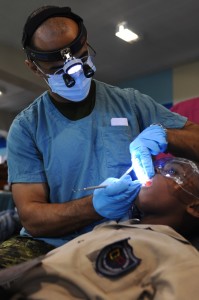
Statistics tell us that a number of North Americans voluntarily delay going to the dentist because they are fearful of the dental experience. One major association people have with pain in the dental office is the fear of injections. To ease the pain, dentists have developed techniques like shaking the cheek while dispensing the anesthetic that greatly facilitates the process. Moreover, there is now a wideA�array of medications and techniques, used alone or in combination, that can reduce or eliminate pain and control anxietyA�during most procedures.
Topical anesthetics
Applied with a swab, topical anesthetics are routinely used to numb the area in the mouth or gums where the dental work will be done. The topical anesthetic is given prior to injection with a local anesthetic, such as Lidocaine. These types of procedures are commonly taught in dental hygienist school.
Laughing gas
This gas, which is administered by a professional with dental assistant training and inhaled by the patient through a face mask, helps with feeling relaxed. Ita��s a common form of sedation used in the dental office, as the effects wear off quickly once the gas is turned off. This is the only form of sedation under which patients can drive after the procedure, or even eat food within a 12-hour period of the procedure. In general, with anesthesia, the patient cana��t drive right after the procedure, or eat after midnight the night before the procedure.
Electronically delivered anesthesia
Also called transcutaneous electrical nerve stimulation, this type of treatment provides an alternative to injections. Adhesive pads are placed on the face and a battery-powered device sends electrical impulses to the treatment area to numb it. The patient controls the level of stimulation through a hand-held unit. Another form of electronically delivered anesthesia is called cranial electrotherapy stimulation. With this technique, electricity is passed into the brain, which causes relaxation. Again, the patient controls the intensity of the current, increasing or decreasing it to control the pain as needed. Advantages of these approaches are that as soon as the device is switched off, the effect is instantly reversed. The patient is able to drive and resume normal activities immediately following the dental visit.
Laser drills
Some dentists are now using lasers to remove decay within a tooth and prepare the surrounding enamel for receipt of the filling. Lasers usually cause less pain, therefore resulting in a reduced need for anesthesia.
Intravenous sedation
This form of pain and anxiety control involves injecting a sedative into a vein of a patient’s arm or hand. This approach is usually reserved for patients undergoing extensive dental procedures or for the extremely anxious patient. Dentists need to monitor the oxygen level of patients receiving IV sedation.
Oral sedation
An oral medication, such as Halcion, can help patients relax by sedating the central nervous system. Oral sedatives are not often prescribed, as they take about 30 minutes to kick in and can cause drowsiness that can last for several hours.
General anesthesia
This technique puts the patient a�?to sleepa�? for the duration of the procedure. Patients requiring general anesthesia can be treated in the dentist’s office by a team of professionals, including the dentist and intra-oral dental assistant, but are more likely to be treated in a hospital setting. This is because this type of anesthesia has risks, such as a sudden drop inA�blood pressure, meaning the patient needs to be closely monitored. For these reasons, general anesthesia is typically only used if extensive dental work is needed and when other forms of sedation or pain control are not sufficient to conquer the patienta��s fears.

